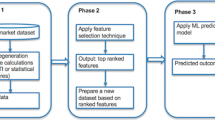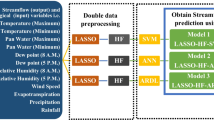Abstract
Wind speed/power prediction plays an important role in large-scale wind power penetration because of the wind volatility and uncertainty. In this paper, an accurate forecast model is presented based on improved wavelet transform, informative feature selection and hybrid forecast engine. The proposed forecasting engine is based on support vector machine which is an appropriate prediction forecast engine due to its ability to discover natural structures of wind speed/power variation. The mentioned forecast engine is equipped with an intelligent algorithm and enhances its prediction accuracy. For this purpose, we applied a new version of enhanced particle swarm optimization in this work as the optimization algorithm. Effectiveness of the proposed forecast model is extensively evaluated by real-world electricity market through comparison with well-known forecasting methods. Obtained numerical results and analysis demonstrate the validity and superiority of the proposed method.








Similar content being viewed by others
References
Abedinia O, Ghasemi A, Ojaroudi N (2016) Improved time varying inertia weight PSO for solved economic load dispatch with subsidies and wind power effects. Complexity 21(4):40–49
Abedinia O, Bekravi M, Ghadimi N (2017) Intelligent controller based wide-area control in power system. Int J Uncertain Fuzziness Knowl Based Syst 25(01):1–30
Abedinia O, Amjady N, Ghadimi N (2018) Solar energy forecasting based on hybrid neural network and improved metaheuristic algorithm. Comput Intell 34(1):241–260
Aghajani G, Ghadimi N (2018) Multi-objective energy management in a micro-grid. Energy Rep 4:218–225
Akbary P, Ghiasi M, Pourkheranjani MRR, Alipour H, Ghadimi N (2017) Extracting appropriate nodal marginal prices for all types of committed reserve. Comput Econ. https://doi.org/10.1007/s10614-017-9716-2
Amjady N, Abedinia O (2017) Short term wind power prediction based on improved Kriging interpolation, empirical mode decomposition, and closed-loop forecasting engine. Sustainability 9(11):2104
Barbounis TG, Theocharis JB, Alexiadis MC, Dokopoulos PS (2006) Long-term wind speed and power forecasting using local recurrent neural network models. IEEE Trans Energy Convers 21(1):273–284
Bhandari B, Lee KT, Lee GY, Cho YM, Ahn SH (2015) Optimization of hybrid renewable energy power systems: a review. Int J Precis Eng Manuf Green Technol 2(1):99–112
Catalao JPS, Pousinho HMI, Mendes VMF (2011) Hybrid wavelet-PSO-ANFIS approach for short-term wind power forecasting in Portugal. IEEE Trans Sustain Energy 2(1):50–59
Dadkhah M, Rezaee MJ, Chavoshi AZ (2018) Short-term power output forecasting of hourly operation in power plant based on climate factors and effects of wind direction and wind speed. Energy 148:775–788
De Giorgi MG, Ficarella A, Tarantino M (2011) Error analysis of short term wind power prediction models. Appl Energy 88(4):1298–1311
Dudek G (2016) Pattern-based local linear regression models for short-term load forecasting. Electr Power Syst Res 130:139–147
Ebrahimian H, Barmayoon S, Mohammadi M, Ghadimi N (2018) The price prediction for the energy market based on a new method. Econ Res Ekonomska Istraživanja 31(1):313–337
Eslami M, Moghadam HA, Zayandehroodi H, Ghadimi N (2018) A new formulation to reduce the number of variables and constraints to expedite SCUC in bulky power systems. In: Proceedings of the national academy of sciences, india section a: physical sciences, pp 1–11
Gelažanskas L, Baranauskas A, Gamage KA, Ažubalis M (2016) Hybrid wind power balance control strategy using thermal power, hydro power and flow batteries. Int J Electr Power Energy Syst 74:310–321
Ghadimi N (2015) A new hybrid algorithm based on optimal fuzzy controller in multimachine power system. Complexity 21(1):78–93
Ghadimi N, Firouz MH (2015) Short-term management of hydro-power systems based on uncertainty model in electricity markets. J Power Technol 95(4):265
Ghadimi N, Afkousi-Paqaleh A, Emamhosseini A (2014) A PSO-based fuzzy long-term multi-objective optimization approach for placement and parameter setting of UPFC. Arab J Sci Eng 39(4):2953–2963
Ghadimi N, Akbarimajd A, Shayeghi H, Abedinia O (2017a) A new prediction model based on multi-block forecast engine in smart grid. J Ambient Intell Humaniz Comput. https://doi.org/10.1007/s12652-017-0648-4
Ghadimi N, Akbarimajd A, Shayeghi H, Abedinia O (2017b) Application of a new hybrid forecast engine with feature selection algorithm in a power system. Int J Ambient Energy. https://doi.org/10.1080/01430750.2017.1412350
Gollou AR, Ghadimi N (2017) A new feature selection and hybrid forecast engine for day-ahead price forecasting of electricity markets. J Intell Fuzzy Syst 32(6):4031–4045
Hamian M, Darvishan A, Hosseinzadeh M, Lariche MJ, Ghadimi N, Nouri A (2018) A framework to expedite joint energy-reserve payment cost minimization using a custom-designed method based on Mixed Integer Genetic Algorithm. Eng Appl Artif Intell 72:203–212
Hassan S, Khosravi A, Jaafar J, Khanesar MA (2016) A systematic design of interval type-2 fuzzy logic system using extreme learning machine for electricity load demand forecasting. Int J Electr Power Energy Syst 82:1–10
Jiang P, Wang Y, Wang J (2017) Short-term wind speed forecasting using a hybrid model. Energy 119:561–577
Jurado S, Nebot À, Mugica F, Avellana N (2015) Hybrid methodologies for electricity load forecasting: entropy-based feature selection with machine learning and soft computing techniques. Energy 86:276–291
Khodaei H, Hajiali M, Darvishan A, Sepehr M, Ghadimi N (2018) Fuzzy-based heat and power hub models for cost-emission operation of an industrial consumer using compromise programming. Appl Therm Eng 137:395–405
Kingsbury NG (1998) The dual-tree complex wavelet transform: a new technique for shift invariance and directional filters. In: Proceedings of 8th IEEE DSP workshop, vol 8, p 86. Utah
Lei M, Shiyan L, Chuanwen J, Hongling L, Yan Z (2009) A review on the forecasting of wind speed and generated power. Renew Sustain Energy Rev 13(4):915–920
Leng H, Li X, Zhu J, Tang H, Zhang Z, Ghadimi N (2018) A new wind power prediction method based on ridgelet transforms, hybrid feature selection and closed-loop forecasting. Adv Eng Inform 36:20–30
Liu Y, Wang W, Ghadimi N (2017) Electricity load forecasting by an improved forecast engine for building level consumers. Energy 139:18–30
Mirzapour F, Lakzaei M, Varamini G, Teimourian M, Ghadimi N (2017) A new prediction model of battery and wind-solar output in hybrid power system. J Ambient Intell Humaniz Comput. https://doi.org/10.1007/s12652-017-0600-7
Mohammadi M, Ghadimi N (2015) Optimal location and optimized parameters for robust power system stabilizer using honeybee mating optimization. Complexity 21(1):242–258
Naikal N, Yang AY, Sastry SS (2011) Informative feature selection for object recognition via sparse PCA. In: Computer vision (ICCV), 2011 IEEE international conference on IEEE, pp 818–825
Nan X, Li Q, Qiu D, Zhao Y, Guo X (2013) Short-term wind speed syntheses correcting forecasting model and its application. Int J Electr Power Energy Syst 49:264–268
National Renewable Energy Laboratory (2012). http://www.nrel.gov/electricity/transmission/eastern_wind_methodology.html
Noruzi A, Banki T, Abedinia O, Ghadimi N (2015) A new method for probabilistic assessments in power systems, combining monte carlo and stochastic–algebraic methods. Complexity 21(2):100–110
Sharifi S, Sedaghat M, Farhadi P, Ghadimi N, Taheri B (2017) Environmental economic dispatch using improved artificial bee colony algorithm. Evolv Syst 8(3):233–242
Shayanfar HA, Abedinia O, Amjady N, Rajaei S (2016) Wind power prediction model based on hybrid strategy. In: Proceedings of the international conference on scientific computing (CSC). The steering committee of the world congress in computer science, computer engineering and applied computing (WorldComp), p 66
Soman SS, Zareipour H, Malik O, Mandal P (2010) A review of wind power and wind speed forecasting methods with different time horizons. In: North American power symposium (NAPS), 2010, pp 1–8. IEEE
Takeda H, Tamura Y, Sato S (2016) Using the ensemble Kalman filter for electricity load forecasting and analysis. Energy 104:184–198
Tang Y, Zhong J, Bollen M (2018) Schedule of air-conditioning systems with thermal energy storage considering wind power forecast errors. Int J Electr Power Energy Syst 95:592–600
Trelea IC (2003) The particle swarm optimization algorithm: convergence analysis and parameter selection. Inf Process Lett 85(6):317–325
Wang X, Guo P, Huang X (2011) A review of wind power forecasting models. Energy Proc 12:770–778
Wu J, Zhang B, Li H, Li Z, Chen Y, Miao X (2014) Statistical distribution for wind power forecast error and its application to determine optimal size of energy storage system. Int J Electr Power Energy Syst 55:100–107
Yeh WC, Yeh YM, Chang PC, Ke YC, Chung V (2014) Forecasting wind power in the Mai Liao Wind Farm based on the multi-layer perceptron artificial neural network model with improved simplified swarm optimization. Int J Electr Power Energy Syst 55:741–748
Zareipour H, Huang D, Rosehart W (2011) Wind power ramp events classification and forecasting: a data mining approach. In: Power and Energy Society General Meeting, 2011 IEEE, pp 1–3. IEEE
Zheng H, Kusiak A (2009) Prediction of wind farm power ramp rates: a data-mining approach. J Solar Energy Eng 131(3):031011
Acknowledgements
This research was financially supported by Key Research Institute of Humanities and Social Science at Universities of Henan. The authors thanks to Emate(www.emate.ac.cn) for their excellent language service, as they had supplied translation and native proofreading from native speakers. Meanwhile, the revisions and suggestion on research method provided by IAMSET, an organizer in academic conferences service, are highly appreciated.
Author information
Authors and Affiliations
Corresponding author
Additional information
Publisher’s Note
Springer Nature remains neutral with regard to jurisdictional claims in published maps and institutional affiliations.
Rights and permissions
About this article
Cite this article
Liu, Z., Hajiali, M., Torabi, A. et al. Novel forecasting model based on improved wavelet transform, informative feature selection, and hybrid support vector machine on wind power forecasting. J Ambient Intell Human Comput 9, 1919–1931 (2018). https://doi.org/10.1007/s12652-018-0886-0
Received:
Accepted:
Published:
Issue Date:
DOI: https://doi.org/10.1007/s12652-018-0886-0




